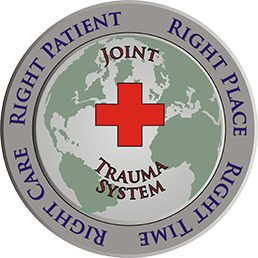History
JTS history is rooted in the effort to improve combat casualty care. JTS visionary COL John B. Holcomb (retired), a US Army general surgeon, is accredited with seeing the tactical need, the operational need, and the strategic need to deploy a trauma system. According to Lieutenant General Douglas J. Robb, Holcomb was the "John the Baptist" of trauma care systems whose "brilliance and diligence and persistence" garnered support one person at a time. These supporters included Army Surgeon General James Peake who sent Holcomb and consultants to study the matter.
The idea of a tri-service trauma system came to Holcomb when he was deployed in the early years of the wars in Iraq and Afghanistan. In such austere locations, the absence of trauma experts and a trauma system was glaring.
"It was intimately clear as I went into Iraq in May 2003 and talked to young medics, forward operating bases, forward surgical teams, combat missions, and combat support hospitals and found there was absolutely no connection of anything to anybody – and I emphasize that," said Holcomb. "There was no communication from prehospital providers to ground units or between the ground units and to Landstuhl where casualties were sent."
Holcomb says the communication disconnect was so profound it was rumored the Surgeon Generals got their information from The Washington Post since the publisher reportedly had a robust data collection and reporting system. The Surgeon Generals were essentially working in "the dark." They didn't know who was receiving what operations much less what were the common injuries.
The revealing Iraq trip prompted Holcomb to recommend the Army Surgeon General create a trauma care system. Holcomb, Robb and other trauma system proponents took the concept a step further by building the foundation under the US Central Command to ensure global tri-service coverage before, during and after theater.
The result was the CENTCOM Joint Theater Trauma System (JTTS), the Joint Trauma System, the DoD Trauma Registry and Combat Casualty Care Conferences to support the educational and training needs of combat medics, surgeons and nurses here and abroad.
Origins
In 2004, the Assistant Secretary of Defense (ASD), Health Affairs (HA) directed all services (Army, Air Force, Navy) Medical Departments to work together to establish a single trauma registry. ASD (HA) Policy Memorandum 04-03, Coordination of Policy to Establish a Joint Theater Trauma Registry, Dec 22, 2004. The mandate was to collect and aggregate combat casualty care epidemiology, treatments, and outcomes essential to understanding the challenges, successes and failures that the military medical corps faced in providing effective and timely care for combat casualties. In June 2013, the JTS was recognized by the Oversight Board of the Defense Centers of Excellence as a Defense Center of Excellence (DCoE). Deputy Assistant Secretary of Defense Policy Memo 19 June 2013, Designation of JTS as a DCoE. The Center of Excellence recognition is awarded to organizations which create value by achieving improvement in outcomes through clinical, educational and research activities. In fall of 2016, the Office of the Under Secretary of Defense for Personnel and Readiness recommended the DoD "establish the JTS, in its role as the DoD Trauma System as the lead agency for trauma in DoD with authority to establish and assure best-practice trauma care guidelines to the Director of the Defense Health Agency, the Services, and the Combatant Commanders." Previously, the JTS was a directorate within the Joint Base Fort Sam Houston, Texas.
The DoD Trauma Registry (DoDTR) is the vehicle to fulfill the JTS mission. JTS was founded to build and manage the DoDTR, a resource to scientifically validate and analyze aggregated data. There is no comparable registry with such a comprehensive collection of DoD trauma injury data. DoDTR contains identified information taken from the medical record, expert clinical inference, scoring and coding schematics, probability determination, and performance improvement data.

